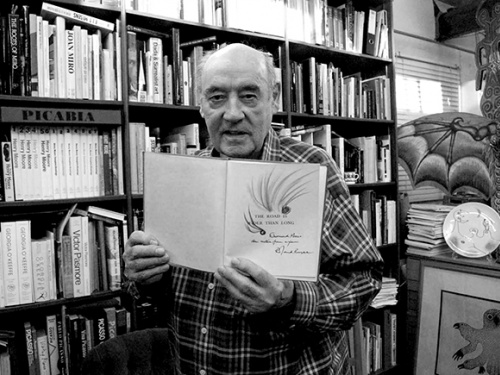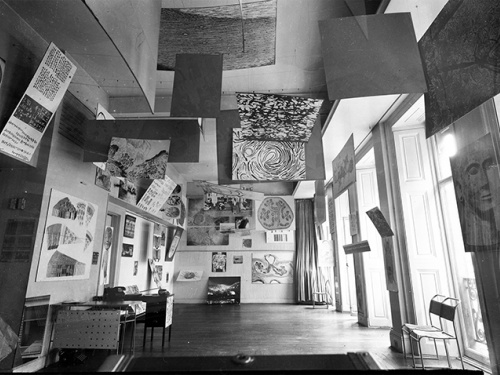The Last Living Surrealist: Desmond Morris on Paintings by Chimpanzees, His Work and the Origins of the ICA
Surrealist painter, zoologist and best-selling author Desmond Morris is known for an impressive list of accomplishments, including being director of the ICA in 1967. Now 88 years old, Morris met with artist and writer Melanie Coles in his Oxford studio to recount his times at the ICA, a place he describes as ‘the seat of rebellion’, home of the surrealists and 'playground' for the avant-garde.
This three-part edited transcript Chimpanzees, Controversy and Contemporary Art: A Conversation with Desmond Morris offers a unique personal insight into the ICA’s subversive origins, recalling first-hand encounters with the legendary characters who roamed the ICA from Herbert Read and Roland Penrose to Pablo Picasso, Francis Bacon, Henry Moore, Barbara Hepworth, Allen Ginsburg and Henri Cartier-Bresson.
I am the last living surrealist. When Dorothea Tanning died, she was 101. I became the last of those who were exhibiting during the period, because I was the youngest. I was just a teenager. I have no idea how I started but it came passionately. The number of people working in the avant-garde in Britain at the time was small. We were a rare breed.
"Dying is the best move you can make as an artist because your prices double... But I haven’t done that."
After the war, there was so much bomb damage full of things that nobody wanted. Junk shops were wonderful places. I couldn’t afford new picture frames or new canvases so I would go there and buy great big paintings of Victorian landscapes for a few shillings and paint over them. One of the pictures I bought for a shilling, I didn’t like because it was traditional. I didn’t like anything traditional in those days—I’m much more mellow now—but I recognised it was ‘good’ so I didn’t paint over it. Just as well because it turned out to be a Gainsborough. So I bought a Gainsborough for shilling! That’s just what you could do in those days. You can’t do that anymore. It’s all gone.
Nobody was buying my paintings at the time. It wan’t until 1987 that they started selling again. When I was a young surrealist painter, I was just giving my paintings away to friends, many of whom became quite well known and eventually passed away. All of a sudden my early work from the 1940s was coming up at auctions like Sotheby’s in famous collections. After that, a gallery took me on, I had regular shows and my work started selling. Now today because I’m so old and they think I’m going to conk out at any minute—which I probably am—they are buying me up before my prices increase. Dying is the best move you can make as an artist because your prices double... But I haven’t done that.
I had been a supporter of the ICA since I went to its very first exhibition in 1947. To me, what the ICA was doing was keeping alive a place for experimentation, a place for rebellion in art. In 1957 I worked with the ICA on the exhibition Paintings by Chimpanzees. This was important because it was the first time that zoology and fine art had come together. It was an experiment to demonstrate the first germ of aesthetic control in painting, looking back in evolution to the chimpanzee. It was a zoological experiment on the roots of human art so it had a place at the ICA.
"Paintings by Chimpanzees was important because it was the first time that zoology and fine art had come together."
The ICA was originally cautious about showing this exhibition because they worried a show of paintings by chimpanzees would ruin their reputation with serious artists - that even the avant-garde would refuse to exhibit at a place that was showing work by apes. But it was decided by founders Roland Penrose and Herbert Read that it was an experiment worthy of discussion and exhibition. I gave a lecture about the scientific aspects so that it was impossible for people to ignore the serious side then wrote the book The Biology of Art to support it. Having read about the exhibition in New York, William Copley, who was a major collector of surrealist art and a surrealist artist himself, decided that the ICA had gone mad. He flew in from New York and arrived in a red dinner jacket and a black bowler hat to make a mockery of it. When he saw that the pictures he changed his mind and said, "No, I’m wrong" and apologised, saying, "I hadn’t realised this was a serious study, I thought it was a joke. I thought the ICA had gone crazy."
Other artists such as Victor Pasmore came to the show. He looked at one of the experimental drawings the ape put on the paper and said: “This is what it’s all about - This is it! This is it!” He got really excited and was completely converted. Picasso, Miro and Dali all understood and were sympathetic too. Roland Penrose gave a painting to Picasso since he had given the ICA a painting. When he looked at the picture he could see that it was serious and thought it was splendid. He later famously bit a journalist who asked why he had a painting by an animal in his collection.
"Picasso famously bit a journalist who asked why he had a painting by an animal in his collection."
When Miro had his show at the Tate and was staying at Farley Farm (where Roland Penrose lived with wife Lee Miller). Roland showed him a Congo painting and Miro could see straight away that it was a composition that he understood and he said, "Oh gosh I would like one of those." So Roland said, "Well, I’ll have a word with Desmond Morris about it." So Miro came out and spent the day with me at the zoo. Roland’s son Anthony was a little boy at the time and he came with us too. He has just written a little children’s book about it called Miro’s Magic Animals. I knew that Miro’s first picture as a school child was of a coiled snake. I think it was his earliest surviving work and I always remembered it because it is extraordinary. So I wrapped a huge python around Joan Miro. He wasn’t worried, he was fascinated. Miro made an image for me in exchange for a Congo painting. I had a chameleon and the chameleon’s tongue stuck out, so when Miro drew a drawing for me he included the tongue and the chameleon’s eyes.
I didn’t meet Dali, unfortunately. I wish I had. But he was taken with some photographs of Congo’s paintings and made his famous remark about Pollock "The hand of the Chimpanzee is quasi-human. The hand of Jackson Pollock is totally animal." He saw that Congo’s work was struggling to make a controlled pattern, whereas, to Dali, Pollock was simply random splashing and he didn’t like that. As we all know, it was very carefully controlled random splashing but it was still random splashing. Incidentally people don’t realise that Pollock’s technique was taught to him by Max Ernst.
"I wrapped a huge python around Joan Miro."
He would fill a tin can with paint, pierce a hole in the bottom of the tin, suspend it by a string and then swing it. Ernst was in New York and showed this young artist, Jackson Pollock, an experiment in which he swung a dripping tin of paint over a canvas to produce random marks. Max Ernst was full of ideas. He had the most magnificently haunted brain of any artist. He was full of extraordinary techniques and it was in one afternoon that he gave Pollock his career.
No serious artist attacked the ICA for the exhibition. They were greatly relieved though they knew that the press was going to have a field day. They knew the traditional art press was going to attack them but they didn’t mind. One or two art critics recognised that it was a serious experiment but of course the tabloids just had fun with it. There were two errors: one was to say it was rubbish and just random dots which it wasn’t, and the other was to say that Congo was a brilliant artist, which he wasn’t. He was just struggling to try and begin to organise patterns. One reviewer reviewed him as though he was a major artist. That annoyed me too because it was mocking of a different kind. They are not great works of art, but they are extraordinary records of an experiment which proves beyond doubt that we aren’t the only species that can control visual patterns. Controlling visual patterns is the essence of art - that’s what visual art is. ■
This transcript is the third of a three-part series Chimpanzees, Controversy and Contemporary Art: A Conversation with Desmond Morris based on an interview by Melanie Coles with Desmond Morris at his studio in Oxford, UK, 2016, and edited by Melanie Coles and Maya Caspari.
2016 is the ICA's 70th Anniversary. To help celebrate our anniversary, we have put out a call to members for any further stories or archive material from the ICA’s illustrious past, in order to record the ICA’s incredible history. Any material should be shared with archives@ica.org.uk.
We are always looking to hear from potential contributors. If you would like to pitch a feature for the ICA Bulletin email blog@ica.org.uk.
This article is posted in: Articles, Blog, Interviews, News
Tagged with: Desmond Morris, Melanie Coles, Surrealism, Chimpanzees Controversy and Contemporary Art: A Conversation with Desmond Morris, The Surrealists, Roland Penrose, Salvador Dali, Herbert Read, ICA History, Archive, From the Archive, Henry Moore, Francis Bacon, Archives, History of Art, Maya Caspari, Chimpanzees, History of the ICA, Surrealist










